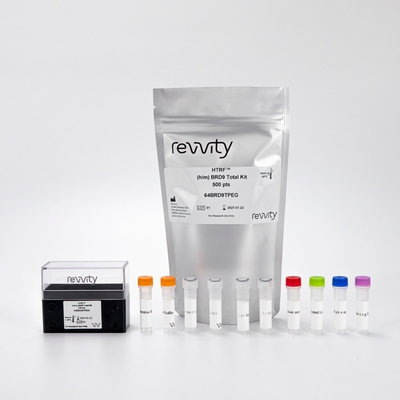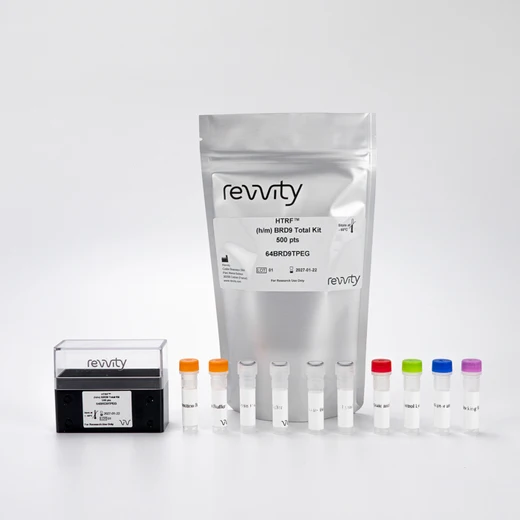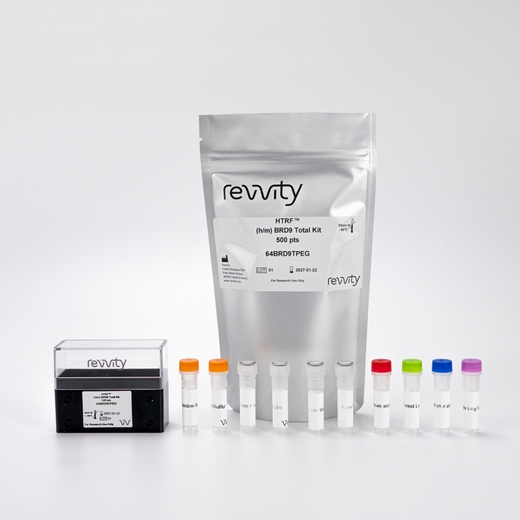

HTRF Human & Mouse Total BRD9 Detection Kit, 500 Assay Points


HTRF Human & Mouse Total BRD9 Detection Kit, 500 Assay Points






The HTRF Human BRD9 kit is designed to monitor the expression level of cellular BRD9 protein.
For research use only. Not for use in diagnostic procedures. All products to be used in accordance with applicable laws and regulations including without limitation, consumption and disposal requirements under European REACH regulations (EC 1907/2006).
| Feature | Specification |
|---|---|
| Application | Cell Signaling |
| Sample Volume | 16 µL |
The HTRF Human BRD9 kit is designed to monitor the expression level of cellular BRD9 protein.
For research use only. Not for use in diagnostic procedures. All products to be used in accordance with applicable laws and regulations including without limitation, consumption and disposal requirements under European REACH regulations (EC 1907/2006).



HTRF Human & Mouse Total BRD9 Detection Kit, 500 Assay Points



HTRF Human & Mouse Total BRD9 Detection Kit, 500 Assay Points



Product information
Overview
BRD9 (BRD9 Bromodomain-containing protein 9) is a member of the bromodomain-containing protein family IV which also includes BRD7. BRD9 is a SWI/SNF (GBAF or ncBAF) subunit and binds acetylated lysine residues of histones, mediating chromatin remodeling and transcriptional regulators. BRD9 is involved in pluripotency regulation and cell development.
BRD9 overexpression has been associated with neurodevelopmental disorders and cancers such as Acute Myeloid Leukemia. Targeting BRD9 degradation via PROTAC molecules has recently emerged as a novel and promising therapeutic approach. However, BRD9 and BRD7 proteins share 72% residue similarity, thus compounds are likely to target both the pro-oncogene BRD9 and the tumor suppressor BRD7. Therefore, the selectivity of compounds targeting either BRD9 or BRD7 must be carefully investigated. To do this, the HTRF total BRD7 kit is a valuable companion assay for the HTRF total BRD9 kit, enabling reliable compound profiling.
Specifications
| Application |
Cell Signaling
|
|---|---|
| Automation Compatible |
Yes
|
| Brand |
HTRF
|
| Detection Modality |
HTRF
|
| Lysis Buffer Compatibility |
Lysis Buffer 1
Lysis Buffer 2
Lysis Buffer 3
Lysis Buffer 4
|
| Molecular Modification |
Total
|
| Product Group |
Kit
|
| Sample Volume |
16 µL
|
| Shipping Conditions |
Shipped in Dry Ice
|
| Target Class |
Phosphoproteins
|
| Target Species |
Human
Mouse
|
| Technology |
TR-FRET
|
| Therapeutic Area |
Oncology & Inflammation
|
| Unit Size |
500 Assay Points
|
Video gallery

HTRF Human & Mouse Total BRD9 Detection Kit, 500 Assay Points

HTRF Human & Mouse Total BRD9 Detection Kit, 500 Assay Points

How it works
Total-BRD9 assay principle
The HTRF Total-BRD9 assay quantifies the expression level of BRD9 in a cell lysate. Unlike Western Blot, the assay is entirely plate-based and does not require gels, electrophoresis, or transfer. The Total-BRD4 assay uses two labeled antibodies: one coupled to a donor fluorophore, the other to an acceptor. Both antibodies are highly specific for a distinct epitope on the protein. In the presence of BRD9 in a cell extract, the addition of these conjugates brings the donor fluorophore into close proximity with the acceptor, and thereby generates a FRET signal. Its intensity is directly proportional to the concentration of the protein present in the sample, and provides a means of assessing the protein’s expression under a no-wash assay format

Total-BRD9 two-plate assay protocol
The two-plate protocol involves culturing cells in a 96-well plate before lysis, then transferring lysates into a 384-well low volume detection plate before the addition of Total-BRD9 HTRF detection reagents. This protocol enables the cells' viability and confluence to be monitored.

Total-BRD9 one-plate assay protocol
Detection of Total-BRD9 with HTRF reagents can be performed in a single plate used for culturing, stimulation, and lysis. No washing steps are required. This HTS designed protocol enables miniaturization while maintaining robust HTRF quality.

Assay validation
Validation on various Human and Mouse cell lines
The adherent Human cell lines MCF7 and MDA-MB-543 cells (mammary gland), HELA (cervix), SH-SY5Y (neuroblast from bone narrow), and Mouse cell lines NIH3T3 and Neuro2A were plated in 96-well culture plates at a density of 100,000 cells /well and incubated for 24 hours at 37°C, 5% CO2. After culture medium removal, the cells were lysed with 50 µL of supplemented lysis buffer #4 (1X).
The suspension immune Human PL-21 cell line (Acute myeloid Leukemia) was dispensed under 30 µL in a 96-well plate at a density of 100,000 cells/well, incubated for 1h at 37°C-5% CO2, and lysed with 10 µL of supplemented lysis buffer #4 (4X).
The BRD9 expression level was assessed with the HTRF Total BRD9 kit. Briefly, 16 µL of cell lysate were transferred into a low volume white microplate followed by 4 µL of premixed HTRF detection reagents. The HTRF signal was recorded after an overnight incubation at RT. The dotted line corresponds to the non-specific HTRF signal. Note that the cell density was previously optimized to ensure HTRF detection within the dynamic range of the kit (data not shown).
The HTRF Total BRD9 assay efficiently detects BRD9 in various cellular models expressing different levels of the protein.

PROTAC® induced BRD9 degradation




MCF7 and HeLa cells were cultured in a 96-well plate (50,000 cells/well) for 24 hours at 37°C, 5% CO2. After cell culture medium removal, they were treated with increasing concentrations of the PROTAC compounds dBRD9 and VZ185, as well as a PROTAC ARV-471 (PROTAC Estrogen Receptor) used as a negative irrelevant control. After overnight incubation, the cell culture medium was removed and 50 µl of supplemented Lysis Buffer#4 (1X) were dispensed into each well. After cell lysis, 16 µL of lysates were transferred into a 384-well low volume white microplate and 4 µL of the HTRF BRD9 detection antibodies were added. The HTRF signal was recorded after an overnight incubation.
In both cell types, the two BRD9 PROTAC degraders triggered a dose-dependent decrease in BRD9 protein, while the expression level of BRD9 in the ARV-471 control conditions as well as the GAPDH remained stable. These results suggest a PROTAC induced specific BRD9 degradation, with a DC50* in the nM range, as expected (Remillard et al. Angew Chem Int Ed Engl. 2017; Zoppi et al.J.Med.Chem. 2019)
DC50 corresponds to the concentration of the degrader at which 50% of the targeted protein is degraded.
PROTAC BRD9 versus BRD7 profiling


| PROTAC® | Described | Warheads | E3L ligands | DC50 (nM) | |
|---|---|---|---|---|---|
| Protein Targets | Total BRD9 | Total BRD7 | |||
| dBRD9 | BRD9 | BI7273 | Pomalidomide (Cereblon Ligand) | 87 | No degradation |
| VZ185 | BRD7 & BRD9 | BI7273 | VH101 | 99 | 87 |
| (VHL Ligand) |
Since BRD9 is an oncogene and BRD7 plays a tumor suppressor role, the selective degradation of BRD9 rather than BRD7 is of major importance.
HeLa cells were cultured in a 96-well plate (50,000 cells/well) for 24 hours at 37°C, 5% CO2. After cell culture medium removal, cells were treated with increasing concentrations of dBRD9 and VZ185 PROTAC compounds. After overnight treatment, the cell culture medium was removed and 50 µl of supplemented Lysis Buffer#4 (1X) were dispensed into each well. After cell lysis, 16 µL of lysates were transferred into a 384-well low volume white microplate and 4 µL of the HTRF detection antibodies were added, using Total BRD9 or Total BRD7 assay reagents. The HTRF signal was recorded after an overnight incubation.
These results indicate a VZ185 induced dose-dependent BRD9 and BRD7 decrease whereas dBRD9 induces a dose-dependent decrease in BRD9 only. GAPDH remained stable in the same conditions (data not shown). This result demonstrates a dBRD9 mediated selective BRD9 degradation, as described by Remillard et al. (Angew Chem Int Ed Engl. 2017) and Zoppi et al.(J.Med.Chem.; 2019).
Specificity of HTRF Total BRD9 assay using knockout HAP1 cell lines
BRD9 expression level was assessed with the HTRF total BRD9 kit in HAP1 cells (WT) and five HAP1 different cell lines knocked-out for BRD9, BRD7 (Family IV), BRD2, BRD3 or BRD4 (BET Family). The cell density was previously optimized to ensure HTRF detection within the dynamic range of the kit (data not shown).
The 6 different cell lines were cultured in a 96-well plate (50,000 cells/well) for 24 hours at 37°C, 5% CO2. After culture medium removal, the cells were lysed with 50 µL of supplemented lysis buffer #4 (1X), then 16 µL of cell lysate were transferred into a low volume white microplate followed by 4 µL of premixed detection reagents. The HTRF signal was recorded after an overnight incubation at RT.
In HAP1 KO BRD9 cells, the HTRF signal was equivalent to the non-specific signal (dotted line) indicating a complete BRD9 gene silencing, whereas the BRD9 level was well detected in the other cell lines, as expected.
Note that i) the BRD9 expression level was significantly higher in HAP1 KO BRD3 cell line, suggesting a compensatory mechanism, ii) Similar expression levels of BRD9 in WT and KO BRD7 cell lines demonstrate the selectivity of the HTRF BRD9 kit over BRD7, as these two proteins share more than 50% sequence homology.
Catalog cell line references (Horizon Discovery) : HAP1 Wt #C631; HAP1 KO BRD9 #HZGHC000934c003; HAP1 KO BRD7 #HZGHC000923c010; HAP1 KO BRD2 # HZGHC000356c015; HAP1 KO BRD3 # HZGHC000244c004; HAP1 KO BRD4 # HZGHC000937c007.

HTRF total BRD9 assay compared to Western Blot
MCF7 cells were cultured in a T175 flask in complete culture medium at 37°C-5% CO2. After a 48h incubation, the cells were lysed with 3 mL of supplemented lysis buffer #4 (1X) after cell medium removal, for 30 minutes at RT under gentle shaking.
Serial dilutions of the cell lysate were performed using supplemented lysis buffer#4, and 16 µL of each dilution were transferred into a low volume white microplate before the addition of 4 µL of HTRF total BRD9 detection reagents.
Equal amounts of lysates were used for a side-by-side comparison between HTRF and Western Blot.
In these conditions, the HTRF total BRD9 assay was 8-fold more sensitive than the Western Blot technique.

dBRD9 PROTAC pharmacology in HTRF and Western Blot
MCF7 were cultured in a 96-well plate (50,000 cells/well) for 24 hours at 37°C, 5% CO2. After cell culture medium removal, cells were treated with increasing concentrations of dBRD9. After overnight treatment, the cell culture medium was removed and 50 µl of supplemented Lysis Buffer#4 (1X) were added to each well. 16µL of the same cell lysates were used to perform Total HTRF BRD9 assay and Western Blot detection using their respective protocols.
Both techniques showed a dBRD9 induces a dose-dependent BRD9 decrease and correlated DC50 (40 nM for HTRF and 90 nM for Western Blot), whereas the GAPDH expression level remained stable (data not shown).

MCF7 were cultured in a 96-well plate (50,000 cells/well) for 24 hours at 37°C, 5% CO2. After cell culture medium removal, cells were treated with increasing concentrations of dBRD9. After overnight treatment, cell culture medium was removed and 50 µl of supplemented Lysis Buffer#4 (1X) was added to each well. 16µL of the same cell lysates were used to perform Total HTRF BRD9 assay and Western blot detection using their respective protocols.
Both techniques show a dBRD9 induces a dose-dependent BRD9 decrease and correlated DC50, whereas GAPDH expression level remains stable (data not shown).
Resources
Are you looking for resources, click on the resource type to explore further.
This guide provides you an overview of HTRF applications in several therapeutic areas.


How can we help you?
We are here to answer your questions.






























